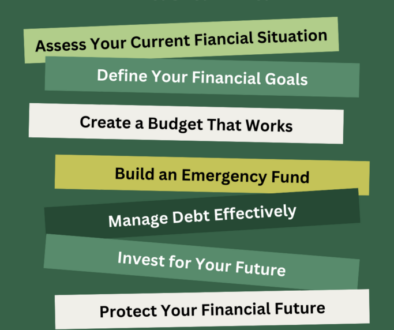Unlocking the Power of Financial Literacy: A Beginner’s Guide
Introduction: The Superpower You Didn’t Know You Had
Money may seem like an everyday necessity, but it holds the potential to unlock your dreams and shape your future. Financial literacy is your gateway to understanding and managing money effectively, turning this ordinary tool into an extraordinary superpower. In this article, we will dive deep into what financial literacy is, why it matters, and how you can use it to take control of your financial journey.
What Is Financial Literacy?
Financial literacy is more than just understanding the numbers in your bank account. It encompasses the skills, knowledge, and confidence needed to make informed and effective financial decisions. Imagine it as your financial GPS, guiding you through earning, spending, saving, and investing wisely.
Breaking Down the Basics
Financial literacy includes a broad range of topics such as:
- Budgeting: Creating a plan for your money to ensure it’s spent wisely.
- Saving: Building a financial cushion for emergencies and future goals.
- Investing: Growing your wealth by putting your money to work.
- Managing credit: Borrowing responsibly to maintain a healthy credit score.
With these tools in your arsenal, you can navigate financial challenges and achieve your goals.
Why Financial Literacy Matters
Imagine playing a video game without knowing the controls. You’d struggle to advance, right? The same applies to managing money. Financial literacy provides the tools you need to succeed in the “game” of life.
Avoiding Financial Pitfalls
Without a solid understanding of finances, many people find themselves trapped in debt or unable to handle unexpected expenses. For instance, statistics reveal that a large percentage of Americans live paycheck to paycheck, with minimal savings to cover emergencies. This highlights the importance of learning how to budget, save, and spend wisely.
Achieving Your Dreams
Financial literacy isn’t just about avoiding problems; it’s also about creating opportunities. Whether it’s buying your first home, starting a business, or traveling the world, understanding your finances can turn your dreams into reality.
The Six Pillars of Financial Literacy
Financial literacy can be broken down into six essential areas, each forming a building block for financial success.
1. Earning Income
Money doesn’t grow on trees, but understanding how to earn it is the first step toward financial independence. Income comes from various sources, such as:
- Salaries: Payment from employment.
- Side Hustles: Extra income from part-time jobs or freelance work.
- Investments: Passive income through stocks, bonds, or real estate.
By diversifying your income streams, you can build a more stable financial foundation.
2. Spending Wisely
Spending is easy, but spending wisely takes practice. Start by distinguishing between needs (essentials like food and housing) and wants (luxuries like dining out or new gadgets). Budgeting can help you:
- Track your spending.
- Prioritize essential expenses.
- Save for future goals.
3. Saving for the Future
Think of saving as planting seeds for tomorrow. Whether it’s an emergency fund or a college fund, saving ensures you’re prepared for life’s uncertainties.
- Emergency Fund: Cover unexpected expenses without debt.
- Long-Term Goals: Save for big-ticket items or major milestones.
4. Investing
Investing is the key to growing your wealth over time. By putting your money into assets like stocks, bonds, or mutual funds, you can benefit from compounding growth. Remember, investing isn’t about getting rich quickly—it’s about building wealth steadily.
5. Managing Credit
Credit can be a powerful tool when used responsibly. Understanding interest rates, credit scores, and loan terms can help you:
- Borrow wisely.
- Avoid high-interest debt.
- Build a strong credit history for future financial opportunities.
6. Protecting Against Risk
Life is full of surprises, and financial literacy can help you prepare for the unexpected. Insurance, for example, protects you against costly accidents or losses, while identity theft prevention safeguards your personal information.
A Real-Life Example: Mia’s Money Makeover
Let’s take a look at Mia, a young professional who turned her financial life around. When Mia got her first job, she spent her entire paycheck on clothes, gadgets, and dining out. One day, her car broke down, and she realized she didn’t have enough savings to cover the repairs.
That was her wake-up call. Mia decided to create a budget, allocating a portion of her income to an emergency fund and setting financial goals. She resisted impulse purchases and learned to differentiate between needs and wants. Over time, Mia saved enough not only to fix her car but also to invest in her education. Today, Mia is financially secure and confident in managing her money.
Mia’s story shows that even small changes in money habits can lead to big results.
How to Start Your Financial Literacy Journey
Ready to take control of your finances? Here are actionable steps to get started:
- Educate Yourself: Read books, take online courses, or follow blogs like this one to learn about financial literacy.
- Set Goals: Define clear financial goals, whether it’s saving for a vacation or paying off debt.
- Create a Budget: Track your income and expenses to identify areas for improvement.
- Start Saving: Open a savings account and set aside money for emergencies and future plans.
- Learn to Invest: Explore beginner-friendly investment options to grow your wealth.
Crafting Your Financial Legacy
Financial literacy is the foundation of a successful and fulfilling life. By understanding how money works and developing smart financial habits, you can achieve your goals and weather any challenges that come your way. Remember, every small step you take toward financial literacy brings you closer to a brighter future. So, start today and take charge of your financial destiny.





